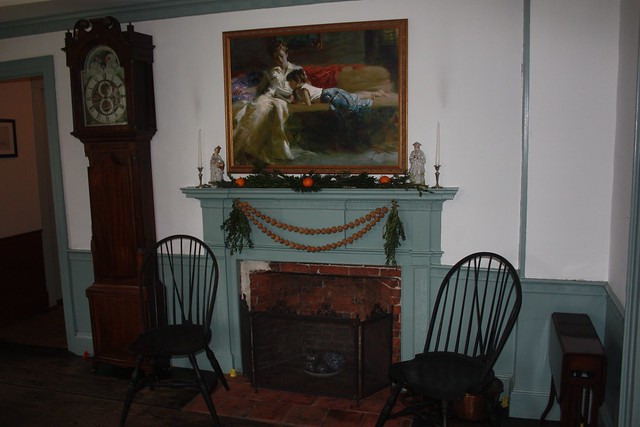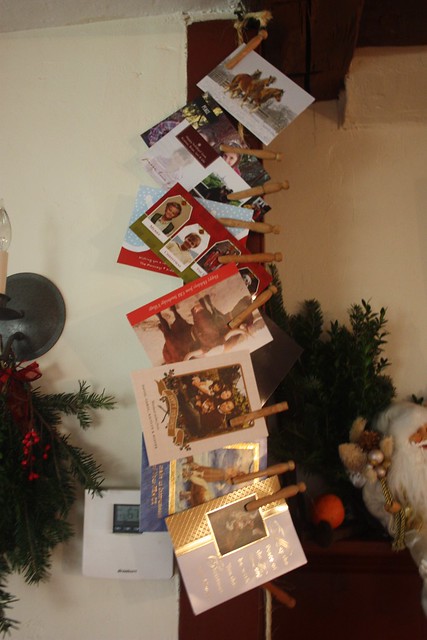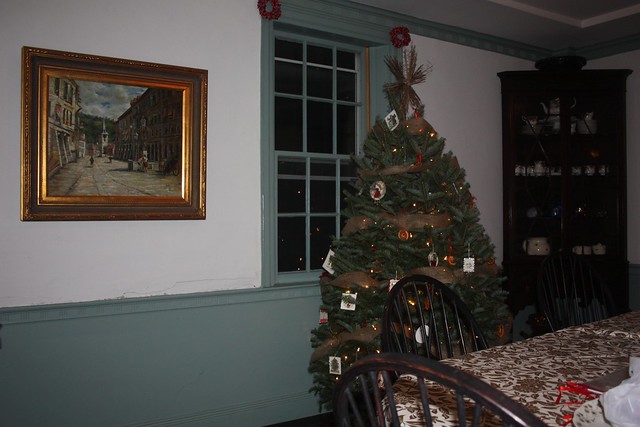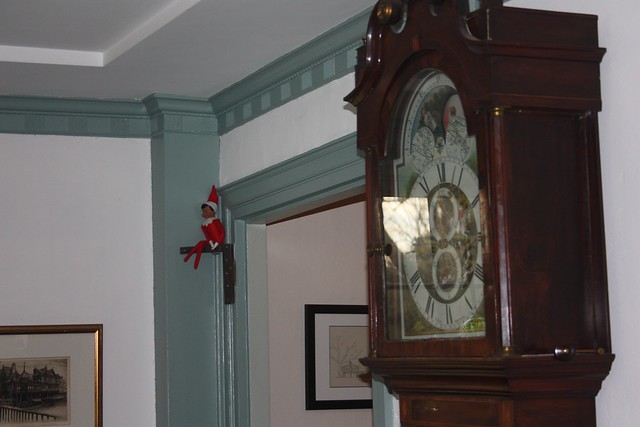A (partially) hand made Christmas.
/I live with a 10 & 5 year old. The past couple of Christmases have involved a lot of plastic, construction and batteries.
Don't get me wrong - I'm not opposed to these things per se. I'm not drawing a line in the sand against 'consumerism', or suggesting I want to deny my kids in the cool toy of the year on some itchy-scratchy granola principle. I just have a little worry that the joy has a risk of being diluted in a shower of glitter, lights and gifts that are too quickly outgrown or broken down.
I have always balked at tinsel, and found more joy in the ornaments my Bride made by hand out of desperation our first year in England, when we realized that we hadn't set our Christmas accoutrements aside for the packers back in California. Combine this with the covetous glances I've annually cast on the 'theme' trees in the local shops, and I made the grand statement that this year, we'd have a "Christmas made by hand!"
When I heard the crazy that had just come out of my mouth I immediately tried to back away from this statement.
"This year," I amended, "We'll have a Christmas with many things made by hand! And by many, I mean some. In this one room over here. Not the main room. Or the main tree. But a few. And it shall be awesome. "
My Bride nodded and pet me on the head. Which proves once again that she has the patience of a saint.
Some of the ideas I had were to look back at some of the ways our home might have been decorated some time ago. It's a 1739 colonial. I wasn't sure how ambitious I could get in the 3 weeks I had between making that statement and our Christmas party, but I figured I'd give it a go.
By starting early, though, I did manage to work in a few things in time for the party. I made garland for the fireplace from walnuts and small wooden beads that I think turned out nicely. It took me about two bags of walnuts to figure out how to drill the hole without cracking the shell. And even then, I'd still lose about one in four. But hey! Garland!
Boxwood and fir branches gathered and hung, and a few clementimes strategically scattered and it feels about right.
Greenery from our yard has always made up a part of our decorations for the Christmas party. It's easy enough to gather in bunches to hang from the sconces and lighting, and it brings the scent and feel of the holidays in the house in a way that I particularly enjoy.
It helps that in both this house and the last, the designers were apparent sconce-o-philiacs, providing 10 or 12 convenient places to mount our holiday swags around the first floor living area.
Thanks, crazy designer!
For years I struggled with the right way to display the Christmas cards we received. It used to be easy to set them out on any flat surface, but then the postcard-photo-of-your-kids became a fad. And what do you do then?
Last year I found a big box of old wooden clothespins. Hang a rope. Hook them on. And make merry with the cards, people.
Also: more greens, and another random orange. Laura Ingles Wilder told me that oranges are Christmas-y. Go with it.
Which probably explains why I sliced and dried a bunch of oranges to hang with red ribbon on the small tree in the dining room. Every year we end up with two trees. Originally, I got an 'extra', smaller tree and called it the 'family' tree, and the big tree was the 'formal' tree - the one with the presents. This was code for "Sure, kids. We can hang your macaroni ornaments on that tree over there."
Somehow I lost control of this, and they got swapped around. But they did leave the little tree up to me. Which is something.
I rounded it off with the old Christmas paper cut-outs from that first Christmas in England I mentioned above, and a simple ribbon garland cut out of plain burlap. The star was made by tying some twiggy garden remnants together.
(I also tried drying lemon slices to complement the orange slices that turned out so prettily. You know what happens when you try and dry lemon slices? They turn black. Which is not at all as Christmas-y as I hoped.)
We let our Elf on the Shelf in on the fun as well. If you haven't experienced the joy of the Elf, it's a little figure that magically moves around your house into new places after the kids are asleep. He watches you all day, and then disappears off to the North Pole to report on your behavior at night, returning before you wake the next day.
You are supposed to name your elf when he appears in your family. Many of our friends named their elf things like "Snowflake," or "Minty," or "Jingles." One friend reported that his kid named their elf "Dragon," because he likes dragons.
Our kids named our elf "Barry James." Because our kids apparently have an instinct for a funky sort of groove.
And who's to say that Santa doesn't need an elf capable of laying down a smooth bass line during the off season?
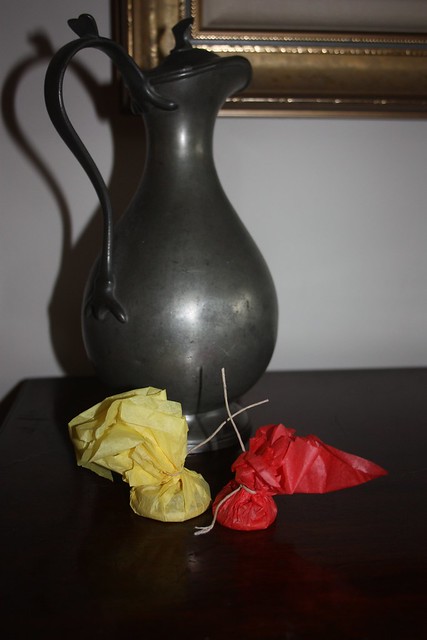
For years, we've been carrying on another of our favorite hand-made traditions. When my Bride was a little girl, her family would hide stacks of coins in all the corners of the house, and on New Year's eve, all the cousins would get together and tear through the house on a mad dash, filling their pockets with change, and scrambling over one another, laughing to find them all. This gave you a little extra cash in your pocket to start the new year on, and a few extra memories of laughter with your cousins.
Our generation was a little slower to create a new crop of cousins, and we've always lived pretty far away from them to boot. So a few years ago, we gave this particular tradition our own twist. We decided to incorporate this as a part of our Christmas party, and make a special point of it with the kids of all the friends and neighbors we invite over. Each year, we make up dozens and dozens of these little crepe paper packages, filled with chocolate and real coins. This year, I think we had about 180 coin packs, expecting around 45 kids. Before the party, I walk around the house, scattering them around the baseboards, in the corners and around the house.
You can tell the kids that have been to our Christmas party before. They're the ones that walk in the house already scanning for the little packs of coins. They nod hello, go distractedly get a plate of food, and walk around the house mumbling to themselves as they spot new hiding places.
About halfway through the party, we gather all the kids, warn the adults to stay towards the centers of the rooms, and countdown "3...2...1... go!"
Kids are everywhere underfoot. And in less than 10 minutes, they're piled around the coffee table or huddled in groups, counting their loot and munching on chocolate.
Maybe it doesn't bring them the same kind of good fortune for the new year, but it provides us with plenty of laughs, and a welcome chance to share a little holiday tradition with our friends.
We still used a lot of our standard ornaments - many of them have special memories because of where we got them, or because of what they represent. But we left a lot packed away as well, and I, at least, took a little more joy from the start of this season because everyone was involved in both coming up with and making the decorations, hanging them on the tree, or getting ready to invite so many of our friends and neighbors over to spend a little time before the holiday.
And somehow, I think we started a new tradition or two this year worth keeping.
